|
Franz Strauss´ horn after the restoration 2001 at the 100th anniversary of his death 1901 |
|
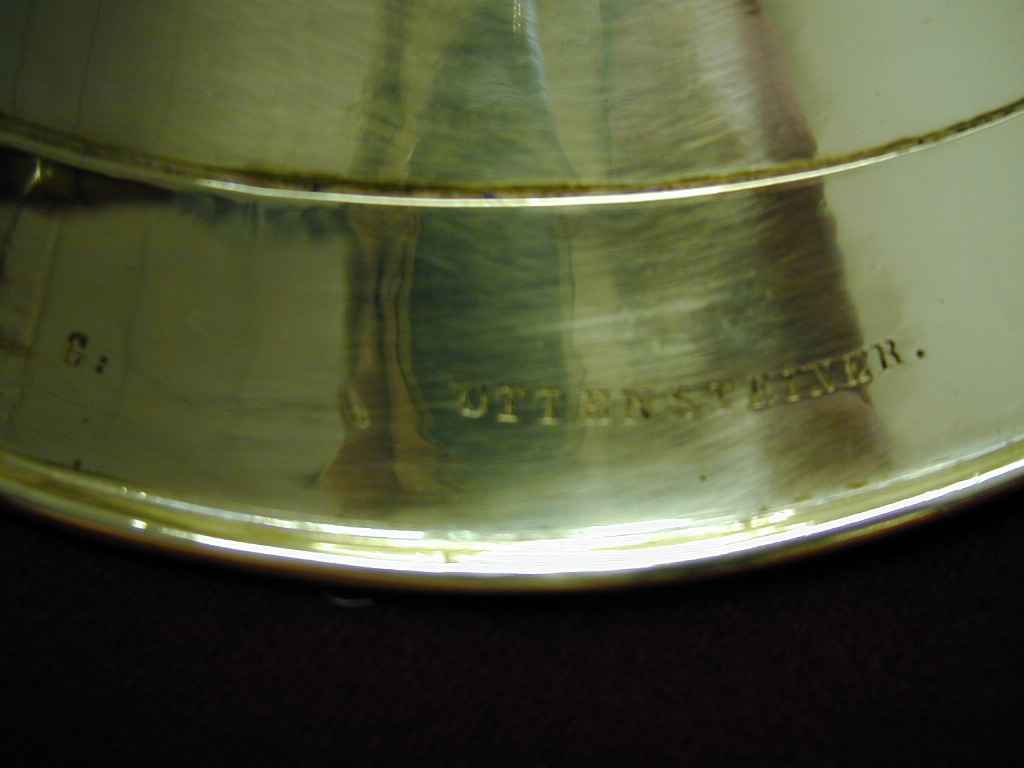 |
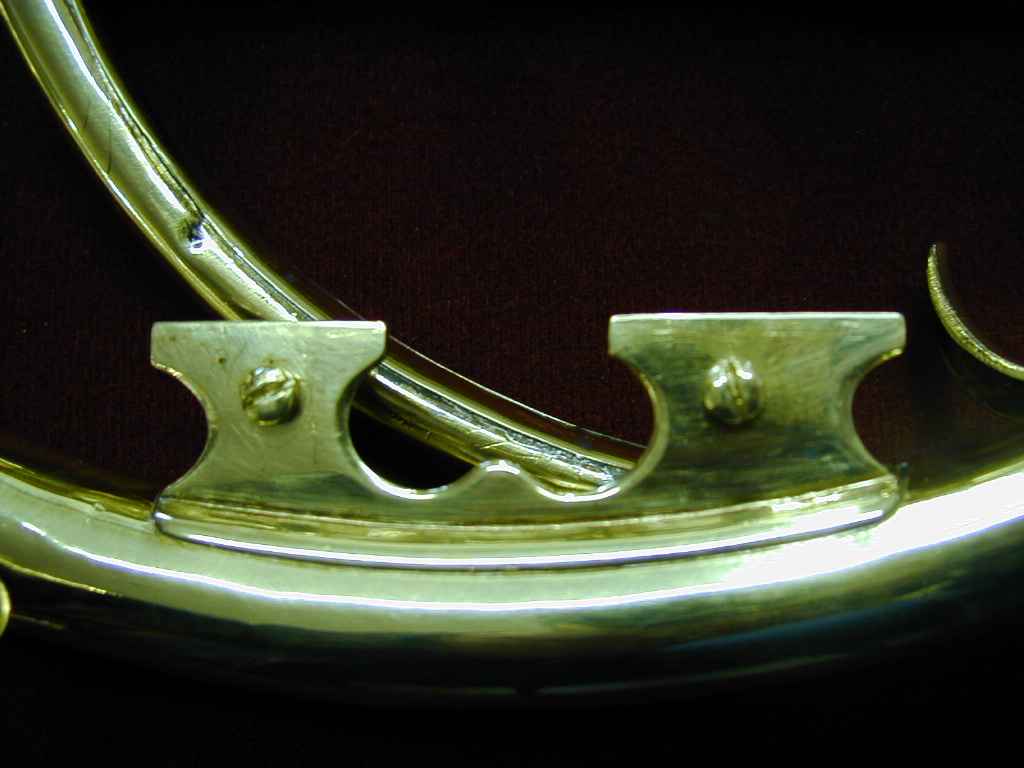 |
| Ottensteiners signature on the kranz - Ottensteiners Signatur | The saddle for the key system - Sattel fuer das Drueckwerk |
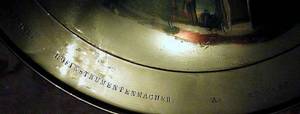 |
The "HOFINSTRUMENTENMACHER A. MÜNCHEN" inscription
|
|
find sound examples at the end of this page |
links zu den Klanbeispielen ganz unten auf dieser Seite |
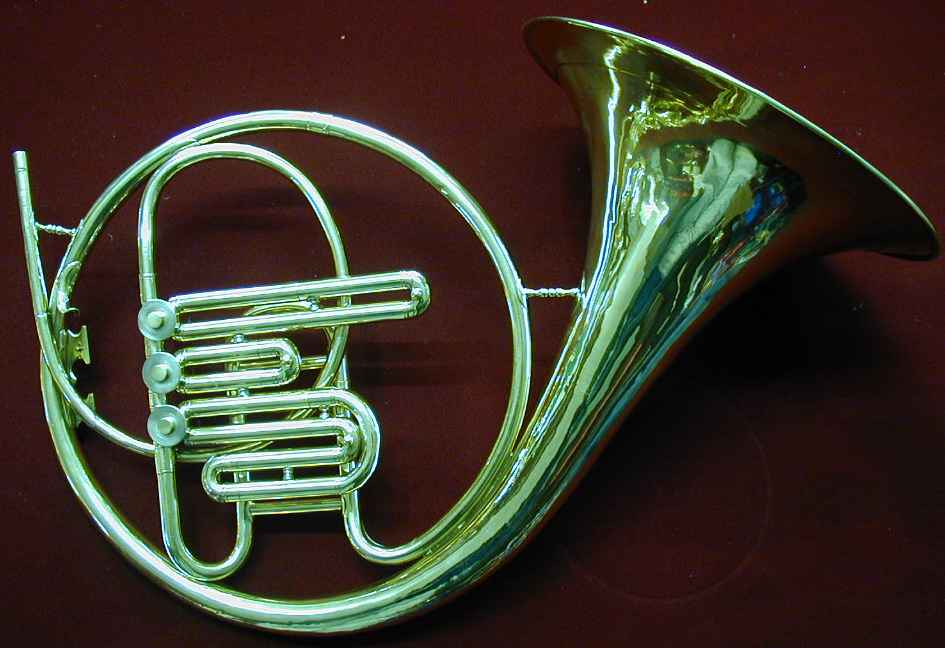 |
 |
|
from below |
from top |
 |
 |
|
Solder joint between body & bell - watch the elegant bell. |
solder joint between body & lead pipe. Watch the careful elaboration |
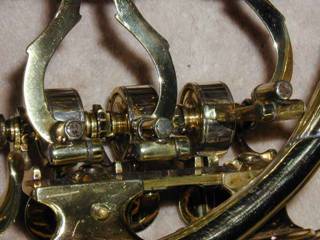 |
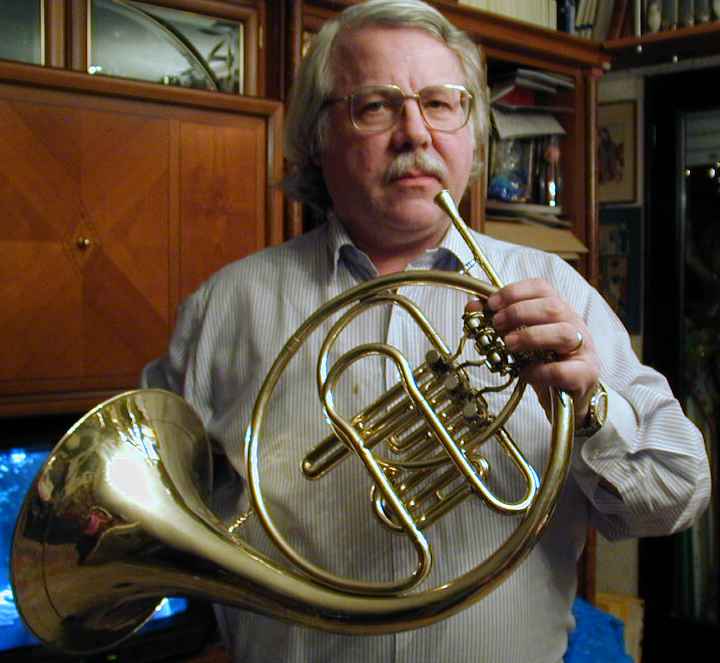 |
|
The key lever system with adjustable clock system the lever system from below, the cross linkage clearly visible |
Hans Pizka with the restored horn |
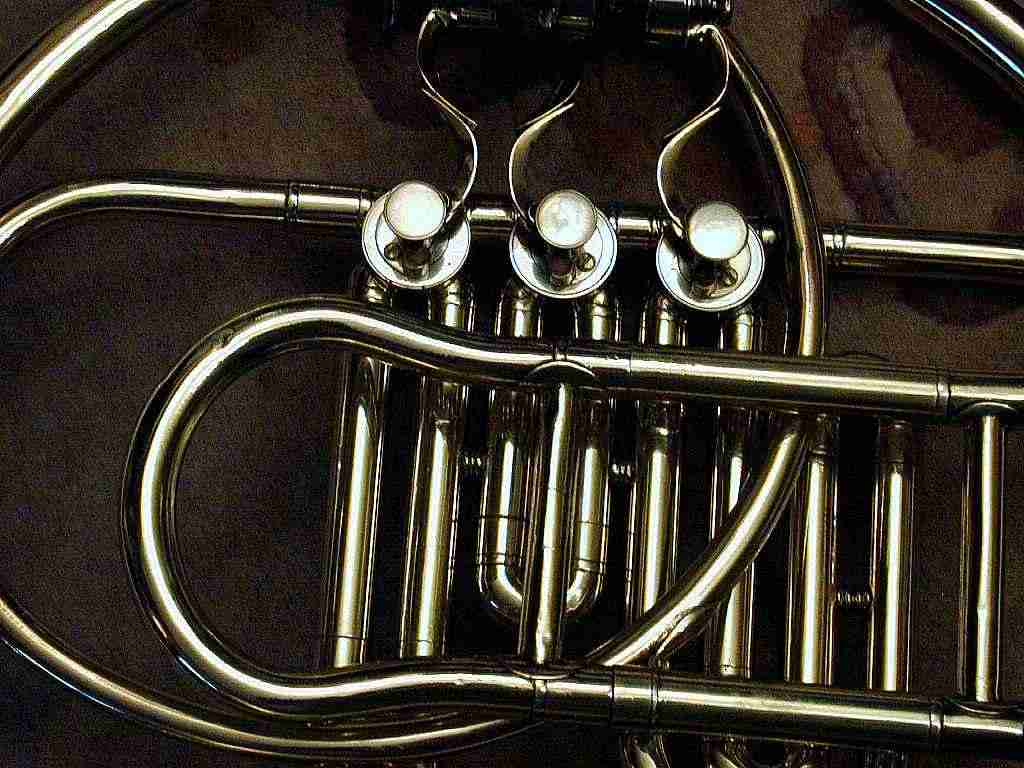 |
 |
| the Paris tuning slide on place | The main tuning slides for A (left), higher older Munich pitch (middle) - used for Bb & F, new Paris pitch (right) |
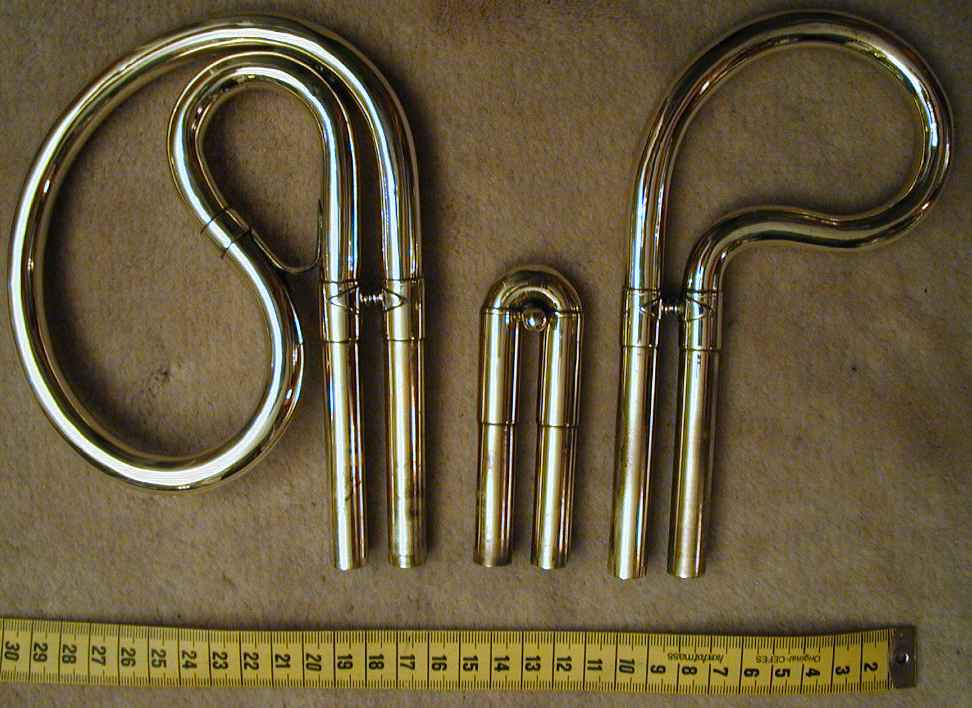
the valve slides for F-horn
|
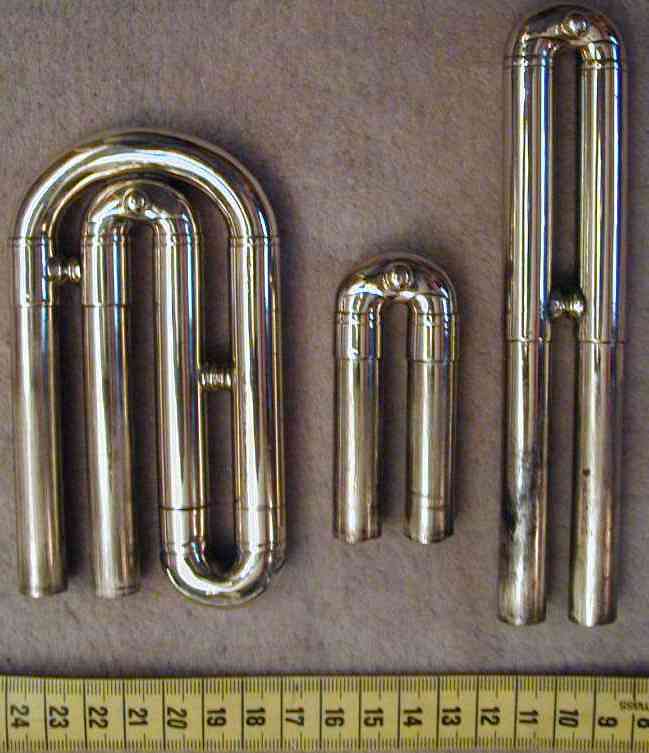 |
|
|
|
 |
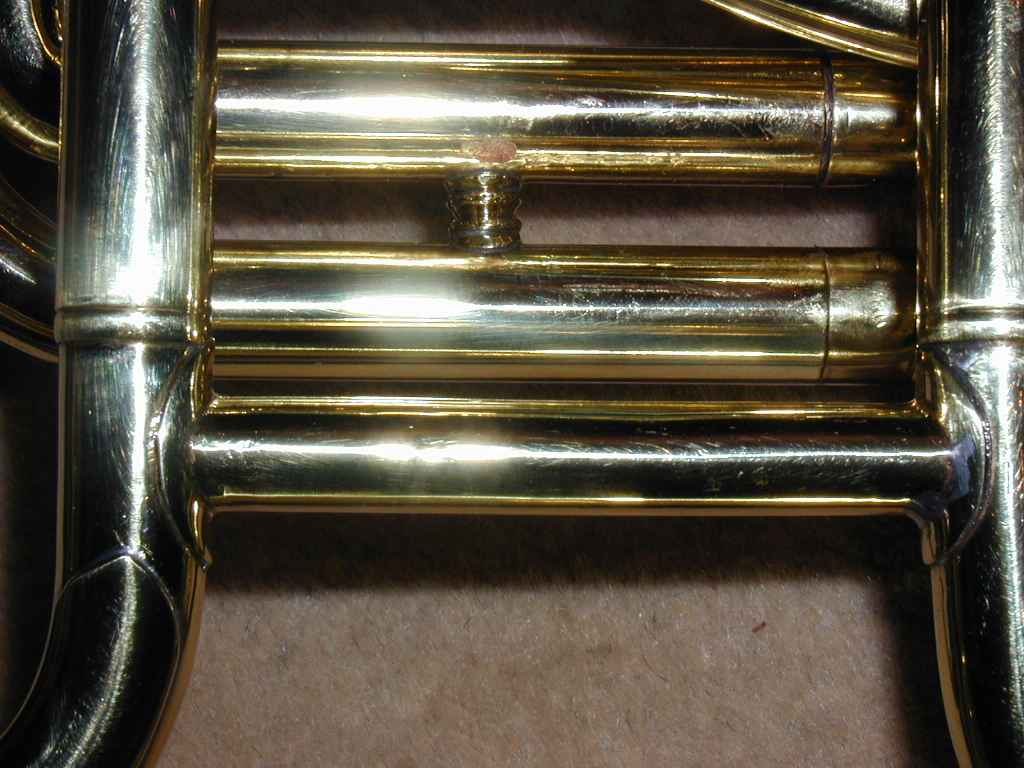 |
| the Bb-slides mounted on the valve system | the solder joint on the maintuning slide; the main tuning slide for F is lost. |
 |
 |
|
Measures: Bb-slides F-slides 1st valve: 334mms 1st valve: 470mms 2nd valve: 165mms 2nd valve: 203mms 3rd valve: 488mms 3rd valve: 756mms |
Abmessungen: B-Zuege F-Zuege 1.Ventil: 334mm 1.Ventil: 470mm 2.Ventil: 165mm 2.Ventil: 203mm 3.Ventil: 488mm 3.Ventil: 756mm |
|
The tuning slides have the following lengths, shafts not calculated: Bb old high Munich pitch: 149 mms Bb new low Paris pitch: 257 mms A: 319 mms The shafts are of 60 mms length each |
Die Stimmzuege haben folgende Laenge (ohne Schaft): B alte Muenchner Stimmung: 149mm B neue Pariser Stimmung: 257mm A: 319mm Die Schaefte sind jeweils 600mm lang. |
|
Main cylindrical bore: 11,4 mms total length of the main tube: 2656 mms (Bb-horn, Munich pitch), 2764 mms (Bb-horn, new Paris pitch) total length of the main tube: 2826 mms (A-horn) The mouthpiece would make it longer for 33 mms. (from 58,5 mms mouth piece length 25,5 mms will be inserted into the lead pipe) Lead pipe opening: 7,7 mms but narrow as 7,45 mms in a depth of 10mm. |
Rohrweite
(Bohrung) im zylindrischen Teil: 11,4 mm Gesamtlaenge: 2656mm (B-Horn, Muenchner Stimmung), 2764mm (B-Horn, neue Pariser Stimmung) Gesamtlaenge fuer A-Horn: 2826mm zusaetzliche Länge durch das Mundstueck: 33mm (von der Gesamtlaenge des Mundstuecks von 58,5mm werden 25,5mm in das Mundrohr gesteckt. Mundrohroeffnung 7,7mm, jedoch in 10mm Tiefe auf 7,45mm verengt |
|
The cylindrical bore: 11,4 mms inner diameter measured at the main slide & cross checked at the other slides Bell diameter: 2890 mms, about the 39-fold of the inner diameter of the lead pipe (7,45 mms), measured 10mms from the initial opening Kranz width: 31 mms Thickness of the wall: 0,40mms |
Der Innendurchmesser (Bohrung) der zylindrischen Rohre wurde am Hauptzug mit 11,4mm gemessen und an weiteren Zuegen ueberprueft. Schallbecherdurchmesser: 2890mm, ungefaehr das 39-fache Mass der Anfangsweite des Mundrohres, gemessen in 10mm Abstand von der Eingangsoeffnung. Messingkranz mit 31mm Weite Blechstaerke: 0,40 mm |
|
The main coil has a diameter of 320 mms (measured from the middle point of the tube on the one side to the middle point of the tube on the opposite side). The valve system is placed at 2/5 of the tube length. The valve cylinders have a diameter of between 20,85mms to 21,60 mms. The outer diameter of the valve casings is 25,40 mms. The bell has one seam only. There is no wedge. |
Die Hauptwindung hat einen Durchmesser von 320 mm, gemessen vom jeweiligen Mittelpunkt des Rohres. Das Ventilsystem ist bei ca. 2/5 der Gesamtlänge des Rohres plaziert. Die Drehzylinder der Ventile haben einen Durchmesser von 20.85 - 21.60 mm im konischen Verlauf. Der Aussendurchmesser der Ventilbuechsen betraegt 25,40 mm. Der Schallbecher hat nur eine Naht. Es gibt keinen Zwickel. |
|
All measures are taken from Dr.Christian Specks article: "Ein Ottensteiner-Horn aus dem Nachlass von Franz Strauss (1822-1905) ) dedicated to Juergen Eppelsheim at the occasion of the 60th anniversary of his birthday, published in MUSIK IN BAYERN , Heft 41/1990. (we both, Dr.Christian Speck & myself are members of Gesellschaft fuer Bayerische Musikgeschichte e.V.). Dr.Specks opinion, that the solder joints & the shape of the bell would resemble some French influence due to the fact that Ottensteiner worked in Paris before 1850, can only be confirmed here. |
Alle Angaben stammen aus Dr.Christian Speck´s Artikel "Ein Ottensteiner-Horn aus dem Nachlass von Franz Strauss (1822-1905), Juergen Eppelsheim aus Anlass des 60.Geburtstages gewidmet, veroeffentlicht in MUSIK IN BAYERN, Heft 41/1990 (Dr.Speck und ich sind beide Mitglieder der Gesellschaft dfuer Bayerische Musikgeschichte e.V.). Dr.Specks Annahme, die Form der Stuetzen und die Form des Schallbechers stellten franzoesischen Einfluss dar, da Ottensteiner doch vor 1830 in Paris arbeitete, kann hier nur noch bestaerkt werden. |
| I have to thank Dr.Speck for his permission to use his article here. All measures have been double checked carefully. | An dieser Stelle moechte ich mich bei Dr.Speck fuer die Erlaubnis, seinen Artikel hier zu zitieren, bedanken. Alle Abmessungen wurden ueberprueft. |
|
Hermann Ganter and myself, we both think, that the horn is just an altered type of the Ottenstein F-horn. The Munich Opera had ordered five horns from Ottensteiner in April 1867, four were in F & one in Bb. All five horns were delivered in the autumn 1867 as the orchestra changed the pitch to the "Paris A". It can be resulted from the measures relations, that these horns were constructed to the rules set by the new lower Paris pitch. The shorter tuning slide was provided, so the player could still play with groups, playing with the unchanged older pitch. |
Hermann Ganter und ich sind der Meinung, dass es sich hier um einen angepassten Typ eines Ottensteiner Horns handelt. Die Muenchner Oper hatte im April 1867 fuenf Hoerner bestellt, vier in F und eines in B. Alle vier Instrumente wurden im Herbst 1867 geliefert, als das Orchester die Stimmung auf das tiefere Pariser A aenderte. Aus den Abmessungen kann geschlossen werden, dass die Instrumente nach den Bedingungen des Pariser A gewbaut wurden. Der kuerzere Stimmzug wurde wohl mitgeliefert, um dem Blaeser die Betaetigung in Ensembles in der alten (hoeheren) Stimmung zu ermoeglichen. |
|
Sound samples (MP3): the harmonic series (Bb-horn): FrStrTon.MP3 from Mastersingers: FrStrMeisters.MP3 from Tristan: FrStrMeisters.MP3 from Mendelssohns Nocturno: FStrTristan.MP3 Siegfried 2nd Act 2nd scene: FStrSiegfried.MP3 Siegfriedruf (until the long e2): FrStrRuf.MP3 Menuetto from Beethovens no.8 Symph.: FrStr8Beeth.MP3 all recordings were made on the spot here in my office, using Franz Strauss´ own mouthpiece with the extreme sharp rim; the samples were not edited. |
Tonbeispiele (MP3): Naturtöne (B-Horn) Meistersinger Tristan Nocturno aus "Sommernachtstraum" Siegfried 2.Akt, 2.Szene Siegfriedruf (bis zur langen e2 Fermata Menuetto aus Beeth. 8.Symph.: alle Aufnahmen sind unter Verwendung von Franz Strauss´ eigenem Mundstueck mit dem extrem scharfen Rand hier in meinem Bureau ohne Tricks aufgenommen; es wurde nichts bearbeitet. |
|
It seems that Franz Strauss altered the pitch of the horn to A by using a different main tuning slide, to play parts written in A or in E & to avoid the "finger-breaking".. To adapt the valve slides, first & third valve slide had a double extension. Franz Strauss participated on the first performances of "Das Rheingold", "Die Walkuere", "Tristan & Isolde", "Die Meistersinger von Nuernberg", "Parsifal" (assisted by Josef Reiter) |
Es scheint,
dass Franz Strauss fuer Stimmen in E und A den Hauptstimmzug auswechselte,
um die "Fingerbrecherei" zu vermeiden. Die Ventilzuege wurden einfach
etwas weiter herausgezogen. Der dritte Zug hatte sogar eine doppelte
Auszugmoeglichkeit. Franz Strauss nahm an den Urauffuehrungen der nebenstehenden Wagner-Opern teil. |
|
Franz Strauss biography: fstrau1.htm His Horn before restoration: fstrau2.htm
|
His compositions: fstrau4.htm His mouthpiece: fstrau5.htm
|
| The following links lead to pages which are
all in German language: Interesting programs & facts about the Court Concerts in Munich: Hofkonz.htm Franz Strauss special vacation & ill leave record: Franz.htm Interesting facts about the social status & the income of the musicians in Munich`s past: MueSoz.htm Interesting facts about the income of horn players of the past: sozial.htm (English) and sozial2.htm (German & English) and Einkomm.htm |
Nachfolgende "links" fuehren meist zu Seiten, die jetzt noch allein in deutscher Sprache verfasst sind: Interessante Programme & Fakten über die Hofkonzerte in Muenchen Franz Strauss´ Sonderurlaub und seine durch Krankheit bedingten Abwesenheiten interessante Fakten zum sozialen Status und dem Einkommen der Muenchner Musiker in der Vergangenheit interessante Fakten ueber das Einkommen der Hornisten in Muenchen |
|
Ticket prices of the past: tickets.htm The first pension fund for musicians, the Haydn Society in Vienna: haydnsoc.htm list & datas of the horn player members. Interesting facts about the Munich horn section (Opera): BSTOrch.htm (who played what, premieres etc.) Interesting facts about the Wagner Festivals held in Munich 1901 - 1911: Wagnerop.htm
|
Eintrittspreise Der erste Pensionsverein fuer Musiker, die Haydn Gesellschaft in Wien, Liste und Daten der Hornisten als Mitglieder interessante Fakten ueber die Horngruppe in Muenchen (Staatsorchester, vorher Hofopernorchester, vorher Hofkapelle); wer spielte was, Premieren, usw. interessante Fakten der Wagner Festspiele 1901-11 |
|
© 2001 by Prof.Hans Pizka, D-85551 Kirchheim, Germany last update 18.01.2006 16:09:55 |
quotings are granted for academic use, but source should be mentioned. |